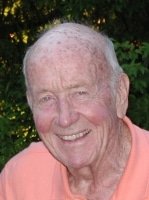



Obituary of Philip Edgar Culbertson
Philip Edgar Culbertson passed away in the early morning of April 4, 2015, after a long battle with
complications of Alzheimer’s disease. He had a long and illustrious career in the aerospace industry
contributing in the fields of missile guidance systems, supersonic flight, and manned space flight.
He is survived by his daughter, Camden Gooch, of Viera, FL, her sons and their wives, Barry (Necia), Jonathan (Celeste), Michael (Mallory), and Andy (Ashley); and son, Philip Culbertson, Jr., his wife Anne,
and their children, Casey and Leah, of West Linn, OR; as well as 11 great-grandchildren. He is preceded in death by his wife Shirley; his sister Jean; and his son-in-law Dr. Brent R. Gooch.
Philip (Phil) was born on August 19, 1925, to Julian and Lucia Culbertson in Pullman, Washington, where he spent his first 18 years with his family. Both of his parents were teachers; Lucia taught high school Greek and Latin, and Julian was the head of the Chemistry department at Washington State College, which later became Washington State University. His parents certainly passed on their academic ability to Phil, as he excelled in his early school years and attended college classes at WSC while still in high school. Upon graduation, Phil enlisted in the Navy initially intending to become a pilot. Those plans changed when World War II ended, and he chose to continue his education, earning
his Bachelors degree in aeronautical engineering from Georgia Tech University. As a commissioned
officer in the Navy, Phil began working on cutting edge missile guidance systems, foreshadowing his career in the space industry. After leaving the Navy, Phil spent four years as a research associate at
the University of Michigan with a focus on designing and wind tunnel testing of advanced supersonic aircraft. It was there that he met Shirley Coskey, and after a whirlwind engagement they were
married in 1950. A year later their first child, Camden, was born. With his Master of Science degree in aeronautical engineering in hand, he accepted a position at General Dynamics/Convair and the new family moved to San Diego, California. Their second child, Philip, Jr. (Cully) was born in 1954 and the family was complete.
Phil’s 11 years at General Dynamics involved engineering and technical management positions including the conversion of the Atlas missile into a manned booster for the Mercury program and as a deep space launch vehicle. He became the principal liaison to NASA, and in 1965 was offered and accepted a position at NASA headquarters in Washington, DC, to begin work on the new Skylab program. Over his 23 year career at NASA, Phil held a multitude of titles and responsibilities covering all of the manned mission programs from the lunar landings through the planning of the International Space Station. His positions were Director, Lunar Mission Studies (1965-1967); Director, Skylab
Integration Program (1967-1969); Director, Advanced Manned Mission Program (1969-1972);
Director, Mission & Payload Integration (1972-1976); Executive Director, President’s Committee on
Science and Technology (1976-1977); Deputy Associate Administrator for Space Transportation
Systems (Technical) (1977-1979); Assistant for the Space Transportation System (1979-1981);
Associate Deputy Administrator (1981-1984); Associate Administrator for Space Station (1984-1985); NASA General Manager (1985-1987); Associate Administrator for Policy and Planning (1987-1988). Phil was also integral in the planning of the Apollo-Soyuz Test Project in 1975, and served as the NASA representative in the 1979 ASAT treaty negotiations.
Phil retired from NASA in 1988, and eventually he and Shirley moved to Cocoa Beach, Florida. He kept
busy in retirement by consulting in the aerospace industry and served as Senior Vice President of the
External Tanks Corporation, which sought funding to create space stations out of spent space shuttle
external tanks. When he actually stopped working he spent time woodworking, playing cards with
friends, and singing in his church choir. Phil dedicated so much of his life to his work that he didn’t
have much free time, but he always found time for family trips to the beach and vacations in Florida, New Hampshire, the Virgin Islands, and many others. He also enjoyed traveling, hiking, fixing anything and everything around the house (he was known as “The Master-Fixer” by his son’s friends), participating in road rallies in his beloved, baby blue Triumph “TR-3” and watching his children in
school activities. He will be remembered by those who loved him not only for his contributions to the space program, but for his dedication in raising a family, and all of the little things that go into the making of a successful and meaningful life. We all loved him very much, and he will be missed.
The family wishes to express sincere appreciation to the staff of Oceania House at The Brennity in
Melbourne, Florida and Vitas Hospice for their loving care of our Dad in his final years.
No services are planned, but in accordance with his final wishes, a portion of Phil’s remains will be
launched into orbit aboard a Celestis, Inc. flight in the near future, when his family will gather for a celebration of his life.If you wish to honor Phil’s memory, donations to the Alzheimer’s Association (alz.org) would be
greatly appreciated.


Copyright © 2024 | Terms of use & privacy policy
 ESPAÑOL
ESPAÑOL  ESPAÑOL
ESPAÑOL 